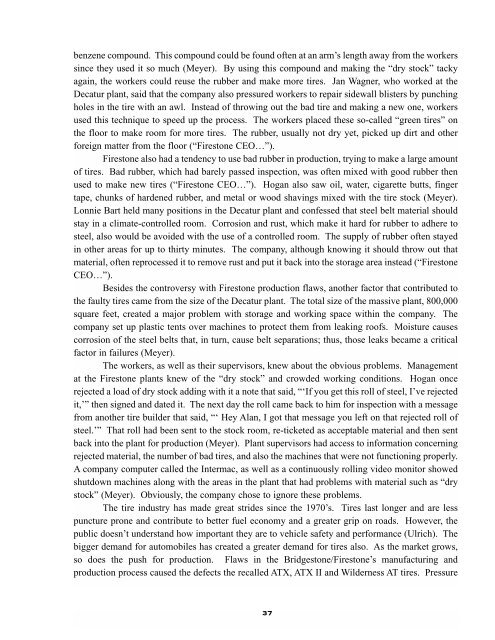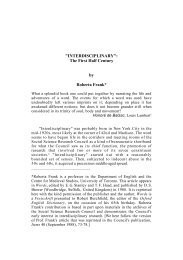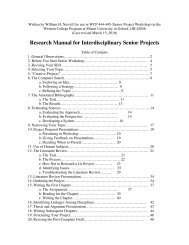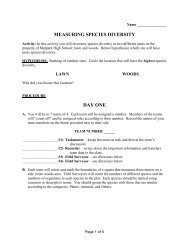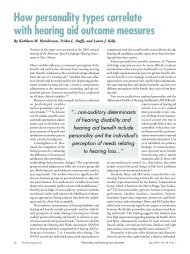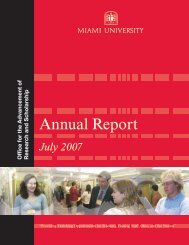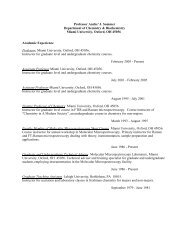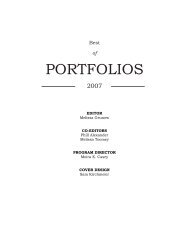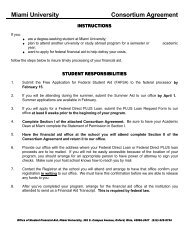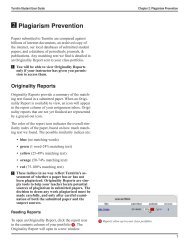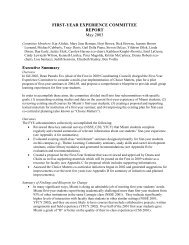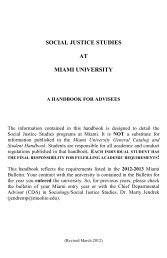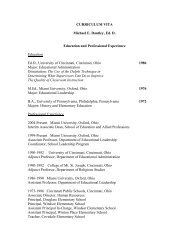Best of Miami Portfolios 2001 - Units.muohio.edu
Best of Miami Portfolios 2001 - Units.muohio.edu
Best of Miami Portfolios 2001 - Units.muohio.edu
Create successful ePaper yourself
Turn your PDF publications into a flip-book with our unique Google optimized e-Paper software.
enzene compound. This compound could be found <strong>of</strong>ten at an arm’s length away from the workers<br />
since they used it so much (Meyer). By using this compound and making the “dry stock” tacky<br />
again, the workers could reuse the rubber and make more tires. Jan Wagner, who worked at the<br />
Decatur plant, said that the company also pressured workers to repair sidewall blisters by punching<br />
holes in the tire with an awl. Instead <strong>of</strong> throwing out the bad tire and making a new one, workers<br />
used this technique to speed up the process. The workers placed these so-called “green tires” on<br />
the floor to make room for more tires. The rubber, usually not dry yet, picked up dirt and other<br />
foreign matter from the floor (“Firestone CEO…”).<br />
Firestone also had a tendency to use bad rubber in production, trying to make a large amount<br />
<strong>of</strong> tires. Bad rubber, which had barely passed inspection, was <strong>of</strong>ten mixed with good rubber then<br />
used to make new tires (“Firestone CEO…”). Hogan also saw oil, water, cigarette butts, finger<br />
tape, chunks <strong>of</strong> hardened rubber, and metal or wood shavings mixed with the tire stock (Meyer).<br />
Lonnie Bart held many positions in the Decatur plant and confessed that steel belt material should<br />
stay in a climate-controlled room. Corrosion and rust, which make it hard for rubber to adhere to<br />
steel, also would be avoided with the use <strong>of</strong> a controlled room. The supply <strong>of</strong> rubber <strong>of</strong>ten stayed<br />
in other areas for up to thirty minutes. The company, although knowing it should throw out that<br />
material, <strong>of</strong>ten reprocessed it to remove rust and put it back into the storage area instead (“Firestone<br />
CEO…”).<br />
Besides the controversy with Firestone production flaws, another factor that contributed to<br />
the faulty tires came from the size <strong>of</strong> the Decatur plant. The total size <strong>of</strong> the massive plant, 800,000<br />
square feet, created a major problem with storage and working space within the company. The<br />
company set up plastic tents over machines to protect them from leaking ro<strong>of</strong>s. Moisture causes<br />
corrosion <strong>of</strong> the steel belts that, in turn, cause belt separations; thus, those leaks became a critical<br />
factor in failures (Meyer).<br />
The workers, as well as their supervisors, knew about the obvious problems. Management<br />
at the Firestone plants knew <strong>of</strong> the “dry stock” and crowded working conditions. Hogan once<br />
rejected a load <strong>of</strong> dry stock adding with it a note that said, “‘If you get this roll <strong>of</strong> steel, I’ve rejected<br />
it,’” then signed and dated it. The next day the roll came back to him for inspection with a message<br />
from another tire builder that said, “‘ Hey Alan, I got that message you left on that rejected roll <strong>of</strong><br />
steel.’” That roll had been sent to the stock room, re-ticketed as acceptable material and then sent<br />
back into the plant for production (Meyer). Plant supervisors had access to information concerning<br />
rejected material, the number <strong>of</strong> bad tires, and also the machines that were not functioning properly.<br />
A company computer called the Intermac, as well as a continuously rolling video monitor showed<br />
shutdown machines along with the areas in the plant that had problems with material such as “dry<br />
stock” (Meyer). Obviously, the company chose to ignore these problems.<br />
The tire industry has made great strides since the 1970’s. Tires last longer and are less<br />
puncture prone and contribute to better fuel economy and a greater grip on roads. However, the<br />
public doesn’t understand how important they are to vehicle safety and performance (Ulrich). The<br />
bigger demand for automobiles has created a greater demand for tires also. As the market grows,<br />
so does the push for production. Flaws in the Bridgestone/Firestone’s manufacturing and<br />
production process caused the defects the recalled ATX, ATX II and Wilderness AT tires. Pressure<br />
37


